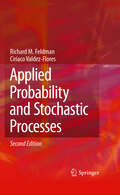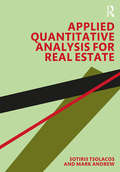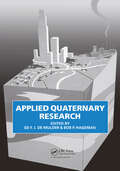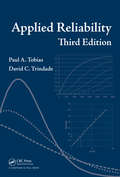- Table View
- List View
Applied Probability and Stochastic Processes
by Richard M. Feldman Ciriaco Valdez-FloresThis book is a result of teaching stochastic processes to junior and senior undergr- uates and beginning graduate students over many years. In teaching such a course, we have realized a need to furnish students with material that gives a mathematical presentation while at the same time providing proper foundations to allow students to build an intuitive feel for probabilistic reasoning. We have tried to maintain a b- ance in presenting advanced but understandable material that sparks an interest and challenges students, without the discouragement that often comes as a consequence of not understanding the material. Our intent in this text is to develop stochastic p- cesses in an elementary but mathematically precise style and to provide suf?cient examples and homework exercises that will permit students to understand the range of application areas for stochastic processes. We also practice active learning in the classroom. In other words, we believe that the traditional practice of lecturing continuously for 50 to 75 minutes is not a very effective method for teaching. Students should somehow engage in the subject m- ter during the teaching session. One effective method for active learning is, after at most 20 minutes of lecture, to assign a small example problem for the students to work and one important tool that the instructor can utilize is the computer. So- times we are fortunate to lecture students in a classroom containing computers with a spreadsheet program, usually Microsoft’s Excel.
Applied Problems Solved by Information Technology and Software (SpringerBriefs in Applied Sciences and Technology)
by Azman Ismail Fatin Nur Zulkipli Mohd Amran Mohd Daril Andreas ÖchsnerThis book explores a dynamic landscape where cutting-edge technologies are revolutionizing various domains. This captivating book delves into the advancements in security, communication, and environmental management, highlighting their profound impact on society. The developments bridge the gap between human needs and technological innovation. Readers will uncover the fascinating world of IoT-driven devices that seamlessly integrate into our lives, ensuring enhanced safety and communication efficiency. This book is a must-read for technology enthusiasts, researchers, and anyone curious about the transformative power of technology in shaping our present and future.
Applied Process Control: Efficient Problem Solving
by Michael MulhollandBridging theory and practice, this book contains over 200 practical exercises and their solutions, to develop the problem-solving abilities of process engineers. The problems were developed by the author during his many years of teaching at university and are kept brief, taken from the fields of instrumentation, modelling, plant control, control strategy design and stability of control. The algorithm flows and codes, which are mostly based on MATLAB®, are given in many cases and allow for easy translation into applications. Since the text is structured according to "Applied Process Control: Essential Methods", all of the necessary background information on the underlying methods can be easily and quickly found in this accompanying book.
Applied Process Control: Essential Methods
by Michael MulhollandThe basic working knowledge for the practicing control engineer in industry, offered here as a handy deluxe edition comprising two volumes each devoted to methods and practical problems. Focusing on the practical implementation, the methods volume provides readers with rapid access to process modelling and control, while including the theoretical background necessary. Throughout, the essential knowledge is built up from chapter to chapter, starting with laying the foundations in plant instrumentation and control. Modelling abilities are then developed by starting from simple time-loop algorithms and passing on to discrete methods, Laplace transforms, automata and fuzzy logic. In the end, readers have the means to design simple controllers on the basis of their own models, and to use more detailed models to test them. With its clarity and simplicity of presentation, and illustrated by more than 200 diagrams, the volume supports self-study and teaches readers how to apply the appropriate method for the application required, and how to handle problems in process control. Bridging theory and practice, the second volume contains over 200 practical exercises and their solutions to develop the problem-solving abilities of process engineers. The problems were developed by the author during his many years of teaching at university and are kept brief, taken from the fields of instrumentation, modeling, plant control, control strategy design and stability of control. The algorithm flows and codes, which are mostly based on MATLAB®, are given in many cases and allow for easy translation into applications. With a clarity and simplicity of presentation, the two volumes are similarly structured for easy orientation.
Applied Process Control: Essential Methods
by Michael MulhollandThe basic working knowledge for the practicing control engineer in industry, offered here as a handy deluxe edition comprising two volumes each devoted to methods and practical problems. Focusing on the practical implementation, the methods volume provides readers with rapid access to process modelling and control, while including the theoretical background necessary. Throughout, the essential knowledge is built up from chapter to chapter, starting with laying the foundations in plant instrumentation and control. Modelling abilities are then developed by starting from simple time-loop algorithms and passing on to discrete methods, Laplace transforms, automata and fuzzy logic. In the end, readers have the means to design simple controllers on the basis of their own models, and to use more detailed models to test them. With its clarity and simplicity of presentation, and illustrated by more than 200 diagrams, the volume supports self-study and teaches readers how to apply the appropriate method for the application required, and how to handle problems in process control. Bridging theory and practice, the second volume contains over 200 practical exercises and their solutions to develop the problem-solving abilities of process engineers. The problems were developed by the author during his many years of teaching at university and are kept brief, taken from the fields of instrumentation, modeling, plant control, control strategy design and stability of control. The algorithm flows and codes, which are mostly based on MATLAB®, are given in many cases and allow for easy translation into applications. With a clarity and simplicity of presentation, the two volumes are similarly structured for easy orientation.
Applied Process Control: Efficient Problem Solving
by Michael MulhollandBridging theory and practice, this book contains over 200 practical exercises and their solutions, to develop the problem-solving abilities of process engineers. The problems were developed by the author during his many years of teaching at university and are kept brief, taken from the fields of instrumentation, modelling, plant control, control strategy design and stability of control. The algorithm flows and codes, which are mostly based on MATLAB®, are given in many cases and allow for easy translation into applications. Since the text is structured according to "Applied Process Control: Essential Methods", all of the necessary background information on the underlying methods can be easily and quickly found in this accompanying book.
Applied Quantitative Analysis for Real Estate
by Sotiris Tsolacos Mark AndrewTo fully function in today’s global real estate industry, students and professionals increasingly need to understand how to implement essential and cutting-edge quantitative techniques. This book presents an easy-to-read guide to applying quantitative analysis in real estate aimed at non-cognate undergraduate and masters students, and meets the requirements of modern professional practice. Through case studies and examples illustrating applications using data sourced from dedicated real estate information providers and major firms in the industry, the book provides an introduction to the foundations underlying statistical data analysis, common data manipulations and understanding descriptive statistics, before gradually building up to more advanced quantitative analysis, modelling and forecasting of real estate markets. Our examples and case studies within the chapters have been specifically compiled for this book and explicitly designed to help the reader acquire a better understanding of the quantitative methods addressed in each chapter. Our objective is to equip readers with the skills needed to confidently carry out their own quantitative analysis and be able to interpret empirical results from academic work and practitioner studies in the field of real estate and in other asset classes. Both undergraduate and masters level students, as well as real estate analysts in the professions, will find this book to be essential reading.
Applied Quantitative Analysis for Real Estate
by Sotiris Tsolacos Mark AndrewTo fully function in today’s global real estate industry, students and professionals increasingly need to understand how to implement essential and cutting-edge quantitative techniques. This book presents an easy-to-read guide to applying quantitative analysis in real estate aimed at non-cognate undergraduate and masters students, and meets the requirements of modern professional practice. Through case studies and examples illustrating applications using data sourced from dedicated real estate information providers and major firms in the industry, the book provides an introduction to the foundations underlying statistical data analysis, common data manipulations and understanding descriptive statistics, before gradually building up to more advanced quantitative analysis, modelling and forecasting of real estate markets. Our examples and case studies within the chapters have been specifically compiled for this book and explicitly designed to help the reader acquire a better understanding of the quantitative methods addressed in each chapter. Our objective is to equip readers with the skills needed to confidently carry out their own quantitative analysis and be able to interpret empirical results from academic work and practitioner studies in the field of real estate and in other asset classes. Both undergraduate and masters level students, as well as real estate analysts in the professions, will find this book to be essential reading.
Applied Quantum Cryptography (Lecture Notes in Physics #797)
by Christian Kollmitzer Mario PivkUsing the quantum properties of single photons to exchange binary keys between two partners for subsequent encryption of secret data is an absolutely novel te- nology. Only a few years ago quantum cryptography – or better Quantum Key Distribution – was the domain of basic research laboratories at universities. But during the last few years things changed. Quantum Key Distribution or QKD left the laboratories and was picked up by more practical-oriented teams that worked hard to develop a practically applicable technology out of the astonishing results of basic research. One major milestone toward a QKD technology was a large research and dev- opment project funded by the European Commission that aimed at combining qu- tum physics with complementary technologies that are necessary to create a tech- cal solution: electronics, software, and network components were added within the project SECOQC (Development of a Global Network for Secure Communication based on Quantum Cryptography) that teamed up all expertise on European level to get a technology for future cryptography.
Applied Quaternary Research
by ED F.J.DE MULDER Bob P. HagemanProceedings of a symposium at the 1987 INQUA Congress, Ottawa, Aug. 1987. Contributions present the application of quaternary studies to land use planning and development. No index. Annotation copyright Book News, Inc. Portland, Or.
Applied Quaternary Research
by B. P. Hageman E. F. J. De MulderProceedings of a symposium at the 1987 INQUA Congress, Ottawa, Aug. 1987. Contributions present the application of quaternary studies to land use planning and development. No index. Annotation copyright Book News, Inc. Portland, Or.
Applied Regression Analysis and Experimental Design
by Richard J. Brook Gregory C. ArnoldFor a solid foundation of important statistical methods, the concise, single-source text unites linear regression with analysis of experiments and provides students with the practical understanding needed to apply theory in real data analysis problems.Stressing principles while keeping computational and theoretical details at a manageable level, Applied Regression Analysis and Experimental Design features an emphasis on vector geometry and least squares to unify and provide an intuitive basis for most topics covered… abundant examples and exercises using real-life data sets clearly illustrating practical of data analysis…essential exposure to MINITAB and GENSTAT computer packages , including computer printouts…and important background material such as vector and matrix properties and the distributional properties of quadratic forms.Designed to make theory work for students, this clearly written, easy-to-understand work serves as the ideal texts for courses Regression, Experimental Design, and Linear Models in a broad range of disciplines. Moreover, applied statisticians will find the book a useful reference for the general application of the linear model.
Applied Regression Analysis and Experimental Design
by Richard J. Brook Gregory C. ArnoldFor a solid foundation of important statistical methods, the concise, single-source text unites linear regression with analysis of experiments and provides students with the practical understanding needed to apply theory in real data analysis problems.Stressing principles while keeping computational and theoretical details at a manageable level, Applied Regression Analysis and Experimental Design features an emphasis on vector geometry and least squares to unify and provide an intuitive basis for most topics covered… abundant examples and exercises using real-life data sets clearly illustrating practical of data analysis…essential exposure to MINITAB and GENSTAT computer packages , including computer printouts…and important background material such as vector and matrix properties and the distributional properties of quadratic forms.Designed to make theory work for students, this clearly written, easy-to-understand work serves as the ideal texts for courses Regression, Experimental Design, and Linear Models in a broad range of disciplines. Moreover, applied statisticians will find the book a useful reference for the general application of the linear model.
Applied Reliability
by Paul A. Tobias David TrindadeSince the publication of the second edition of Applied Reliability in 1995, the ready availability of inexpensive, powerful statistical software has changed the way statisticians and engineers look at and analyze all kinds of data. Problems in reliability that were once difficult and time consuming even for experts can now be solved with a few well
Applied Reliability and Quality: Fundamentals, Methods and Procedures (Springer Series in Reliability Engineering)
by Balbir S. DhillonEach industry, from robotics to health care, power generation to software, has its own tailored reliability and quality principles, methods, and procedures. This book brings these together so that reliability and quality professionals can more easily learn about each other's work, which may help them, directly or indirectly, to perform their tasks more effectively.
Applied Reliability Engineering and Risk Analysis: Probabilistic Models and Statistical Inference (Quality and Reliability Engineering Series)
by Ilia B. Frenkel Alex Karagrigoriou Anatoly Lisnianski Andre V. KleynerThis complete resource on the theory and applications of reliability engineering, probabilistic models and risk analysis consolidates all the latest research, presenting the most up-to-date developments in this field.With comprehensive coverage of the theoretical and practical issues of both classic and modern topics, it also provides a unique commemoration to the centennial of the birth of Boris Gnedenko, one of the most prominent reliability scientists of the twentieth century. Key features include: expert treatment of probabilistic models and statistical inference from leading scientists, researchers and practitioners in their respective reliability fields detailed coverage of multi-state system reliability, maintenance models, statistical inference in reliability, systemability, physics of failures and reliability demonstration many examples and engineering case studies to illustrate the theoretical results and their practical applications in industry Applied Reliability Engineering and Risk Analysis is one of the first works to treat the important areas of degradation analysis, multi-state system reliability, networks and large-scale systems in one comprehensive volume. It is an essential reference for engineers and scientists involved in reliability analysis, applied probability and statistics, reliability engineering and maintenance, logistics, and quality control. It is also a useful resource for graduate students specialising in reliability analysis and applied probability and statistics.Dedicated to the Centennial of the birth of Boris Gnedenko, renowned Russian mathematician and reliability theorist
Applied Reliability Engineering and Risk Analysis: Probabilistic Models and Statistical Inference (Quality and Reliability Engineering Series)
by Ilia B. Frenkel Alex Karagrigoriou Anatoly Lisnianski Andre V. KleynerThis complete resource on the theory and applications of reliability engineering, probabilistic models and risk analysis consolidates all the latest research, presenting the most up-to-date developments in this field.With comprehensive coverage of the theoretical and practical issues of both classic and modern topics, it also provides a unique commemoration to the centennial of the birth of Boris Gnedenko, one of the most prominent reliability scientists of the twentieth century. Key features include: expert treatment of probabilistic models and statistical inference from leading scientists, researchers and practitioners in their respective reliability fields detailed coverage of multi-state system reliability, maintenance models, statistical inference in reliability, systemability, physics of failures and reliability demonstration many examples and engineering case studies to illustrate the theoretical results and their practical applications in industry Applied Reliability Engineering and Risk Analysis is one of the first works to treat the important areas of degradation analysis, multi-state system reliability, networks and large-scale systems in one comprehensive volume. It is an essential reference for engineers and scientists involved in reliability analysis, applied probability and statistics, reliability engineering and maintenance, logistics, and quality control. It is also a useful resource for graduate students specialising in reliability analysis and applied probability and statistics.Dedicated to the Centennial of the birth of Boris Gnedenko, renowned Russian mathematician and reliability theorist
Applied Reliability for Engineers
by B.S. DhillonEngineering systems and products are an important element of the world economy and each year billions of dollars are spent to develop, manufacture, operate, and maintain systems and products around the globe. Because of this, global competition is requiring reliability professionals to work closely with other departments involved in engineering development during the product design and manufacturing phase. Applied Reliability for Engineers is an attempt to meet the need for a single volume that addresses a wide range of applied reliability topics. The material is treated in such a manner that the reader will require no previous knowledge to understand the text. The sources of most of the information presented are given in a reference section at the end of each chapter. At appropriate places, the book contains examples along with their solutions. At the end of each chapter there are numerous problems to test reader comprehension. This volume is thus suitable for use as a textbook as well as for reference. Applied Reliability for Engineers is useful to design professionals, system engineers, reliability specialists, graduate and senior undergraduate students, researchers and instructors of reliability engineering, and engineers-at-large.
Applied Reliability for Engineers
by B.S. DhillonEngineering systems and products are an important element of the world economy and each year billions of dollars are spent to develop, manufacture, operate, and maintain systems and products around the globe. Because of this, global competition is requiring reliability professionals to work closely with other departments involved in engineering development during the product design and manufacturing phase. Applied Reliability for Engineers is an attempt to meet the need for a single volume that addresses a wide range of applied reliability topics. The material is treated in such a manner that the reader will require no previous knowledge to understand the text. The sources of most of the information presented are given in a reference section at the end of each chapter. At appropriate places, the book contains examples along with their solutions. At the end of each chapter there are numerous problems to test reader comprehension. This volume is thus suitable for use as a textbook as well as for reference. Applied Reliability for Engineers is useful to design professionals, system engineers, reliability specialists, graduate and senior undergraduate students, researchers and instructors of reliability engineering, and engineers-at-large.
Applied Reliability for Industry 1: Predictive Reliability for the Automobile, Aeronautics, Defense, Medical, Marine and Space Industries
by Abdelkhalak El Hami David Delaux Henri GrzeskowiakApplied Reliability for Industry 1 illustrates the multidisciplinary state-of-the-art science of predictive reliability. Many experts are now convinced that reliability is not limited to statistical sciences. In fact, many different disciplines interact in order to bring a product to its highest possible level of reliability, made available through today's technologies, developments and production methods. These three books, of which this is the first, propose new methods for analyzing the lifecycle of a system, enabling us to record the development phases according to development time and levels of complexity for its integration. Predictive reliability, as particularly focused on in Applied Reliability for Industry 1, examines all the engineering activities used to estimate or predict the reliability performance of the final mechatronic system.
Applied Reliability for Industry 1: Predictive Reliability for the Automobile, Aeronautics, Defense, Medical, Marine and Space Industries
by Abdelkhalak El Hami David Delaux Henri GrzeskowiakApplied Reliability for Industry 1 illustrates the multidisciplinary state-of-the-art science of predictive reliability. Many experts are now convinced that reliability is not limited to statistical sciences. In fact, many different disciplines interact in order to bring a product to its highest possible level of reliability, made available through today's technologies, developments and production methods. These three books, of which this is the first, propose new methods for analyzing the lifecycle of a system, enabling us to record the development phases according to development time and levels of complexity for its integration. Predictive reliability, as particularly focused on in Applied Reliability for Industry 1, examines all the engineering activities used to estimate or predict the reliability performance of the final mechatronic system.
Applied Reliability for Industry 2
by Abdelkhalak El Hami David Delaux Editor Henri GrzeskowiakApplied Reliability for Industry 2 illustrates the multidisciplinary state-of-the-art science of experimental reliability. Many experts are now convinced that reliability is not limited to statistical sciences. In fact, many different disciplines interact in order to bring a product to its highest possible level of reliability, made available through today’s technologies, developments and production methods.
Applied Reliability for Industry 2
by Abdelkhalak El Hami David Delaux Henri GrzeskowiakApplied Reliability for Industry 2 illustrates the multidisciplinary state-of-the-art science of experimental reliability. Many experts are now convinced that reliability is not limited to statistical sciences. In fact, many different disciplines interact in order to bring a product to its highest possible level of reliability, made available through today's technologies, developments and production methods. These three books, of which this is the second, propose new methods for analyzing the lifecycle of a system, enabling us to record the development phases according to development time and levels of complexity for its integration. Experimental reliability, as advanced in Applied Reliability for Industry 2, examines all the tools and testing methods used to demonstrate the reliability of the final mechatronic system.
Applied Reliability for Industry 3
by David Delaux Abdelkhalak El Hami Henri GrzeskowiakApplied Reliability for Industry 3 illustrates the multidisciplinary state-of-the-art science of operational reliability. Many experts are now convinced that reliability is not limited to statistical sciences. In fact, many different disciplines interact in order to bring a product to its highest possible level of reliability, made available through today’s technologies, developments and production methods. These three books, of which this is the third, propose new methods for analyzing the lifecycle of a system, enabling us to record the development phases according to development time and levels of complexity for its integration. Operational reliability, as presented in Applied Reliability for Industry 3, verifies the reliability performance of the mechatronic system in real life through an analysis of field data.
Applied Reliability for Industry 3
by Abdelkhalak El Hami David Delaux Henri GrzeskowiakApplied Reliability for Industry 3 illustrates the multidisciplinary state-of-the-art science of operational reliability. Many experts are now convinced that reliability is not limited to statistical sciences. In fact, many different disciplines interact in order to bring a product to its highest possible level of reliability, made available through today’s technologies, developments and production methods. These three books, of which this is the third, propose new methods for analyzing the lifecycle of a system, enabling us to record the development phases according to development time and levels of complexity for its integration. Operational reliability, as presented in Applied Reliability for Industry 3, verifies the reliability performance of the mechatronic system in real life through an analysis of field data.














